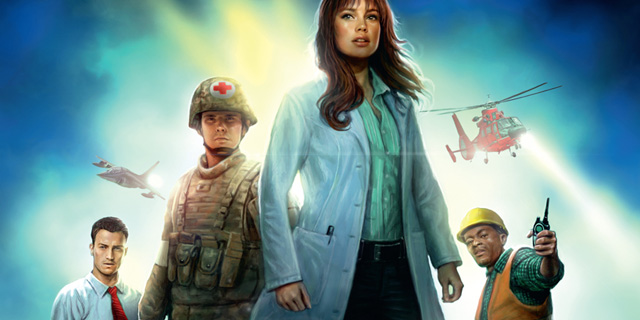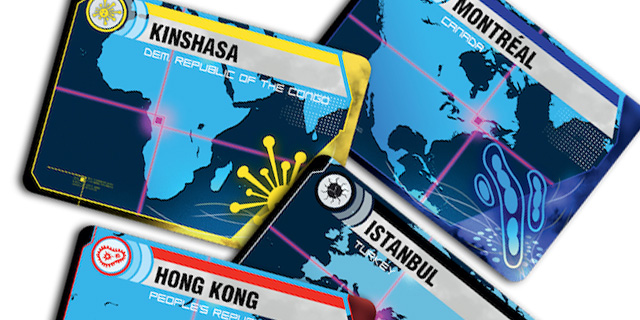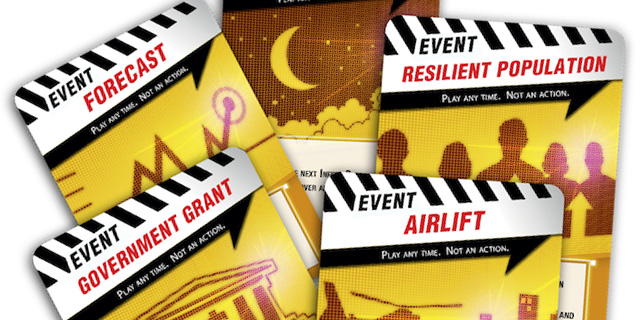
I’m pretty sure I’ve mentioned Pandemic a few times before, most notably in my review of Matt Leacock’s other major cooperative offering Forbidden Island. It also made a brief appearance in my Best of 2008 list, but I’ve never given it a column to itself. Now seemed like a good time to correct that, as a new edition has just hit the shelves of your local game store — and, perhaps more visibly, your local Target and other mainstream retailers as well.
While not the first cooperative board game I ever played (that honor goes to Shadows over Camelot, or possibly even Hero Quest depending on how you want to define the term), Pandemic is often the go-to example when illustrating the genre as it was really the title that brought that design element to the forefront and did so in an impactful way, being nominated for a ton of awards back when it was first released. The players represent a team of specialists that are trying to find cures for four strains of disease that are infecting various cities around the world. Like many cooperative games, there is only one way to win (find four cures) but several ways to lose.

The game begins with the initial outbreaks, with nine cities on the board receiving cubes as indicated by their corresponding Infection card. Each player is dealt two Player cards, and then that deck is seeded with a number of Epidemic cards dependent on how how difficult the group wants the game to be. Everyone starts at the research station in Atlanta (home of the CDC). Each turn, a player has four actions they can take and five ways they can spend those actions:
- Move to a new city, either by traveling along the connections on the board one action at a time, using a player card to fly directly to the indicated city, using a city’s card while in that same city to fly anywhere they want, or moving directly from one Research Station to another.
- Treat (remove) one cube of disease in their current city, or all cubes of a given color if the cure has been found.
- Give or receive the city card of their current location to/from another player sharing that location.
- Build a new research station by using their location’s city card.
- Find a cure by discarding five city cards of the same color while at a research station.
Players might also discover special (non-city) cards that can be used at any time, even another player’s turn, for no action.

At the end of their turn, a player draws two cards. If the players ever exhaust the player deck, they have lost, so the game is definitely on a clock. If one of those cards is an Epidemic card, it is revealed and bad things happen: a new city (drawn from the bottom of the Infection deck) receives three cubes, and the Infection deck discard pile (including that new card) is shuffled and placed on top of the Infection deck, thus ensuring that the next few Infection draws will be cities that have previously been infected. Finally, whether an Epidemic is drawn or not, a number of Infection cards equal to the current infection rate (which increases with every Epidemic card) are discarded from the top of the deck, with each revealed city receiving an additional disease cube.
This is when the real problems begin. If a city drawn during the Infection phase already has three cubes of a color it is receiving, it instead causes an outbreak, placing a cube of that color on every connected city. If any of those cities already have three cubes of that color, a chain reaction continues until this is no longer true. Every outbreak is a strike against the players, and letting the eighth outbreak happen will end the game. The players will also lose if they have to place a cube of a color when there are no cubes of that color remaining. The lesson here is simply to make those three-cube cities a priority!

Playing Pandemic can feel like trying to hold back floodwaters with a coffee mug at times, but that’s what gives the game its thrill. Both board and hand management are crucial to success, and having to spend precious city cards and the potential cure they represent in order to move more efficiently or build a research station is a necessary evil. The excessive restrictions on giving cards to other players is often the key obstacle that needs to be overcome, however, as otherwise you are just relying on the luck of the draw to get there, which is a recipe for a swift defeat.
Fortunately, it is not all doom and gloom for the players. As mentioned, special action cards can really turn a situation around when played at the right time. But more importantly, you have to make the best use out of each player’s special abilities. There are five different roles in the base game, and the new edition introduces two more, each with their own unique talents. Of course, not all of these abilities will be at your disposal (the game caps at four players), but hey. On the plus side, if the players manage to cure a disease and then eradicate all cubes of that color from the board, that color will never appear again, which means that a quarter of the draws from the Infection deck become glorious blanks instead of potential backbreakers. You don’t need to do this in order to win (you only need to discover the cures), but any breather you can get will be a welcome one.
Even at is most basic difficulty level, Pandemic can be hard. A series of unfortunate Infection draws combined with inconveniently-timed Epidemics can cascade into a lethal chain of outbreaks or forcing too many cubes on to the board without there really being anything the players could have done about it. The other common losing scenario is the players being unable to assemble cures in a timely manner due to awkward draws or an increased need to spend cards for actions, resulting in the exhaustion of the Player deck while each player uselessly holds one or two cards of each color. Whatever the reason, the game will beat you fairly often, but that just makes your victories all the sweeter.

Like most any cooperative game, however, the biggest obstacle to an enjoyable experience is the “quarterbacking” problem, in which one veteran player basically plays the game by themselves, telling the other players what to do instead of letting them figure it out on their own. You never want to be That Guy, but the line between helpful suggestions and outright coaching is a blurry one at best, and if one player doesn’t seem to be “getting it” the problem can quickly turn into a feedback loop. Still, that’s not really a fault with the game as much as it is a failing of players who want to win.
A successful game of Pandemic can take up to an hour to complete, although some victories and most defeats can happen much quicker. Pandemic retails for about $40, although if you pick up the new edition, be aware that there is an error on the board that somehow omitted the connection between Sao Paolo and Lagos. Hopefully this will be corrected in future printings.



















